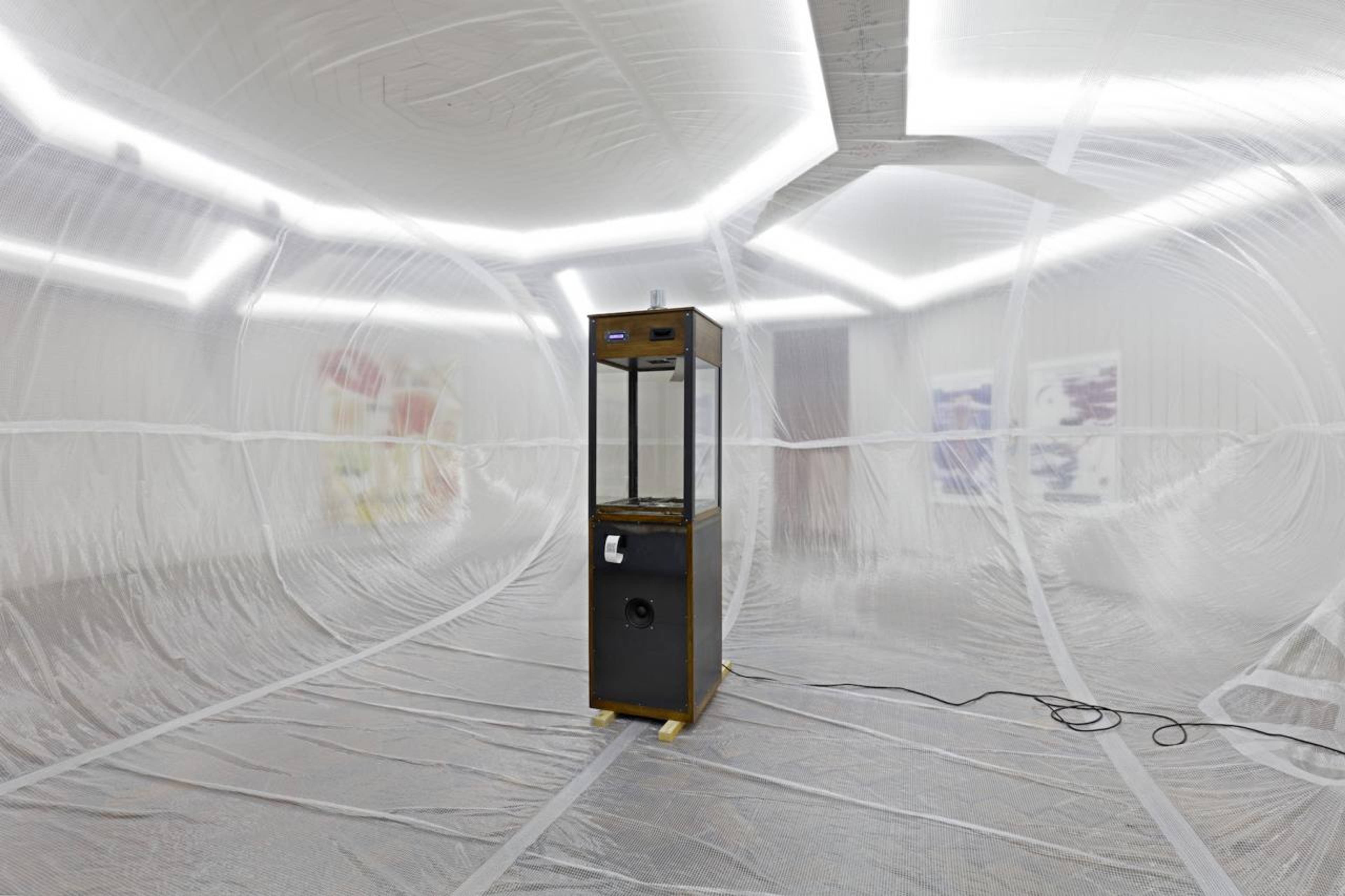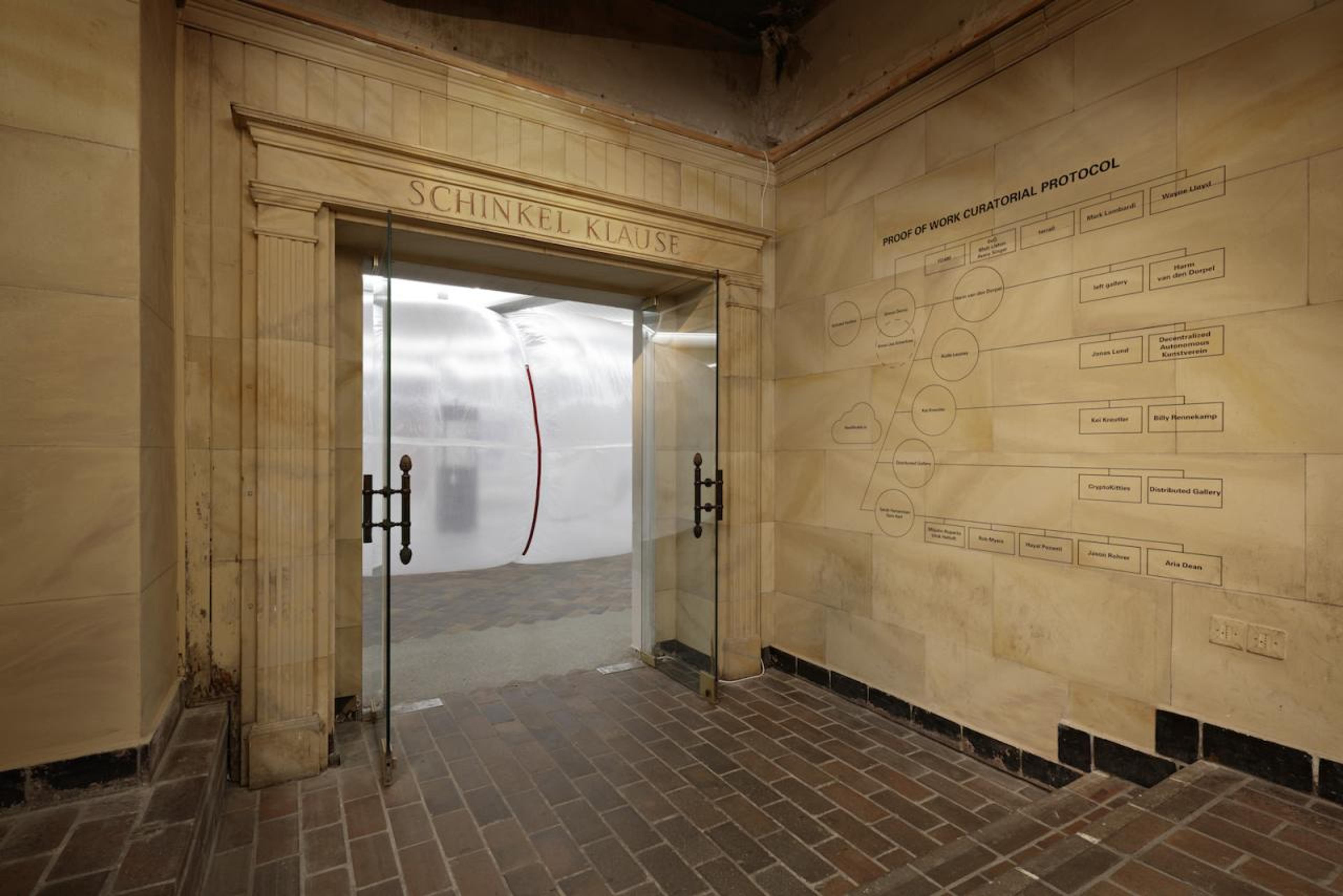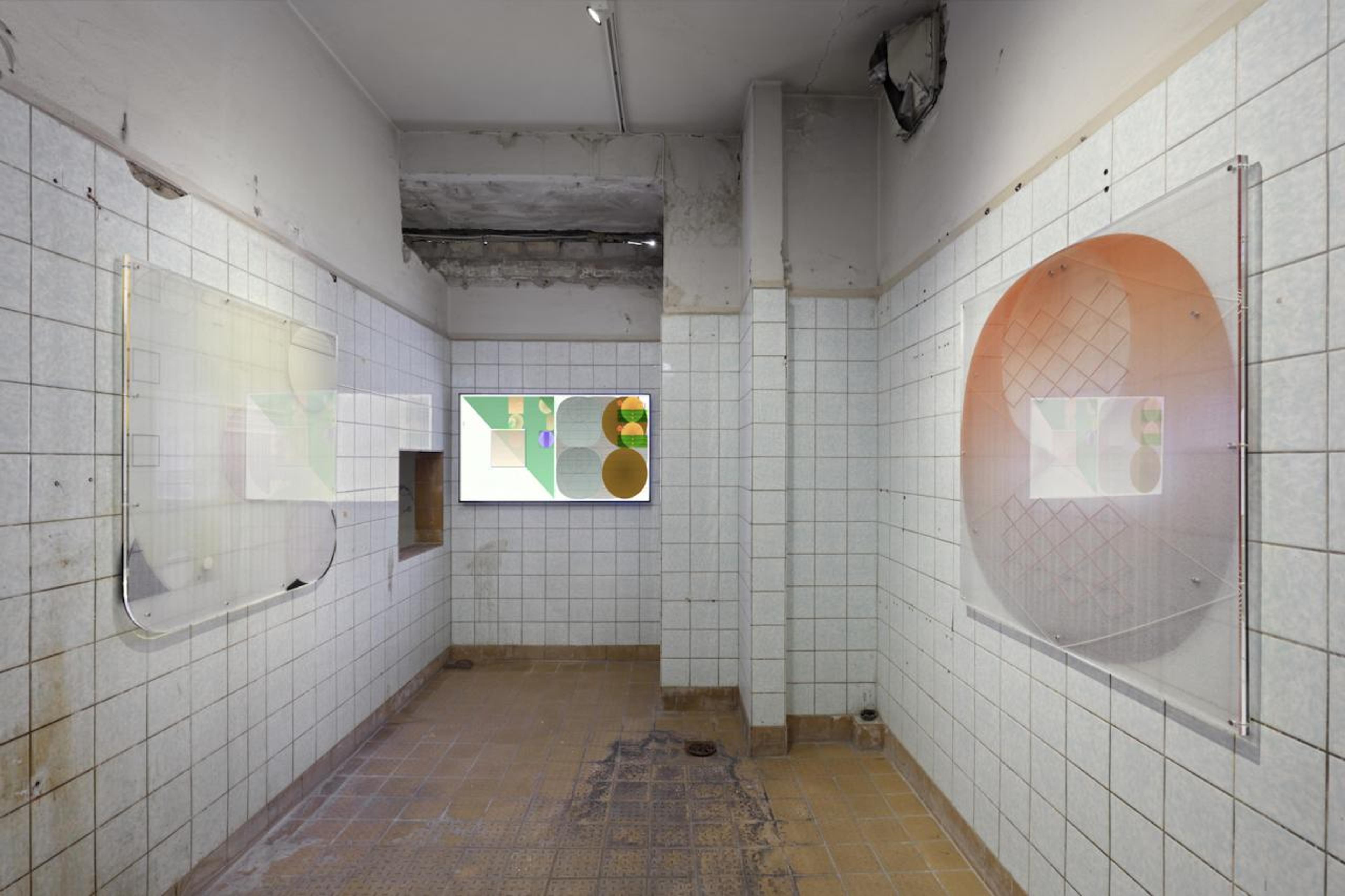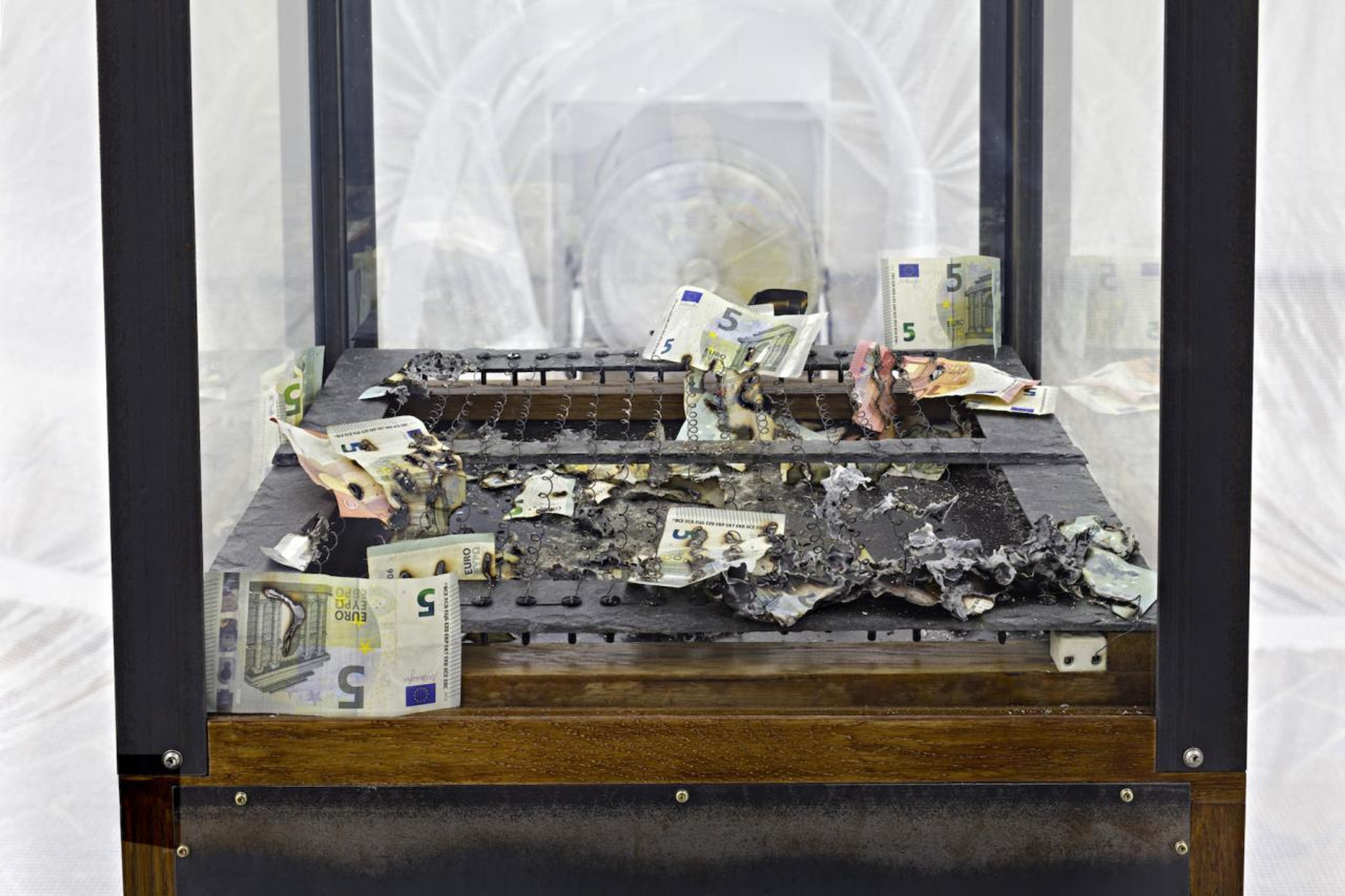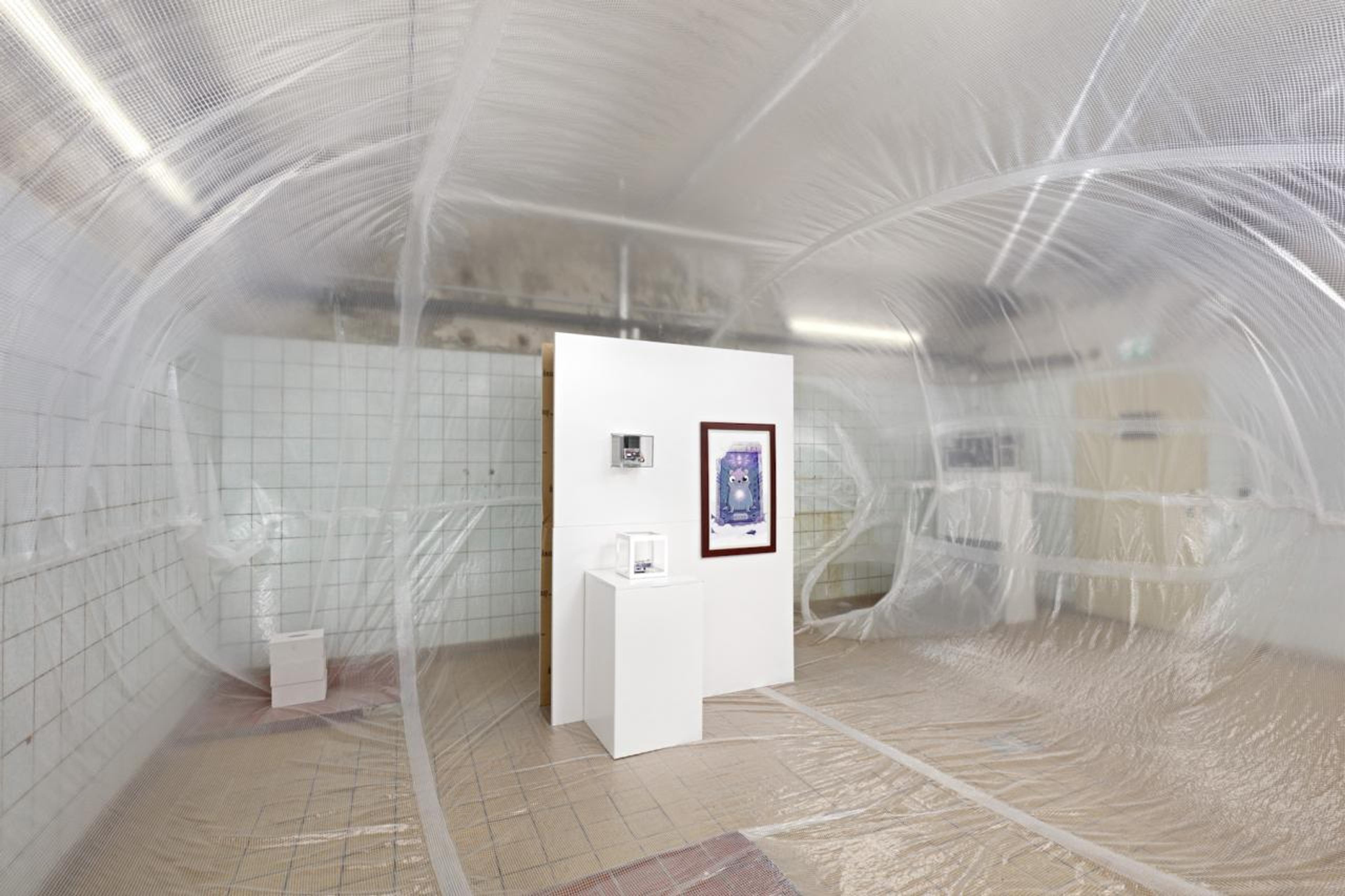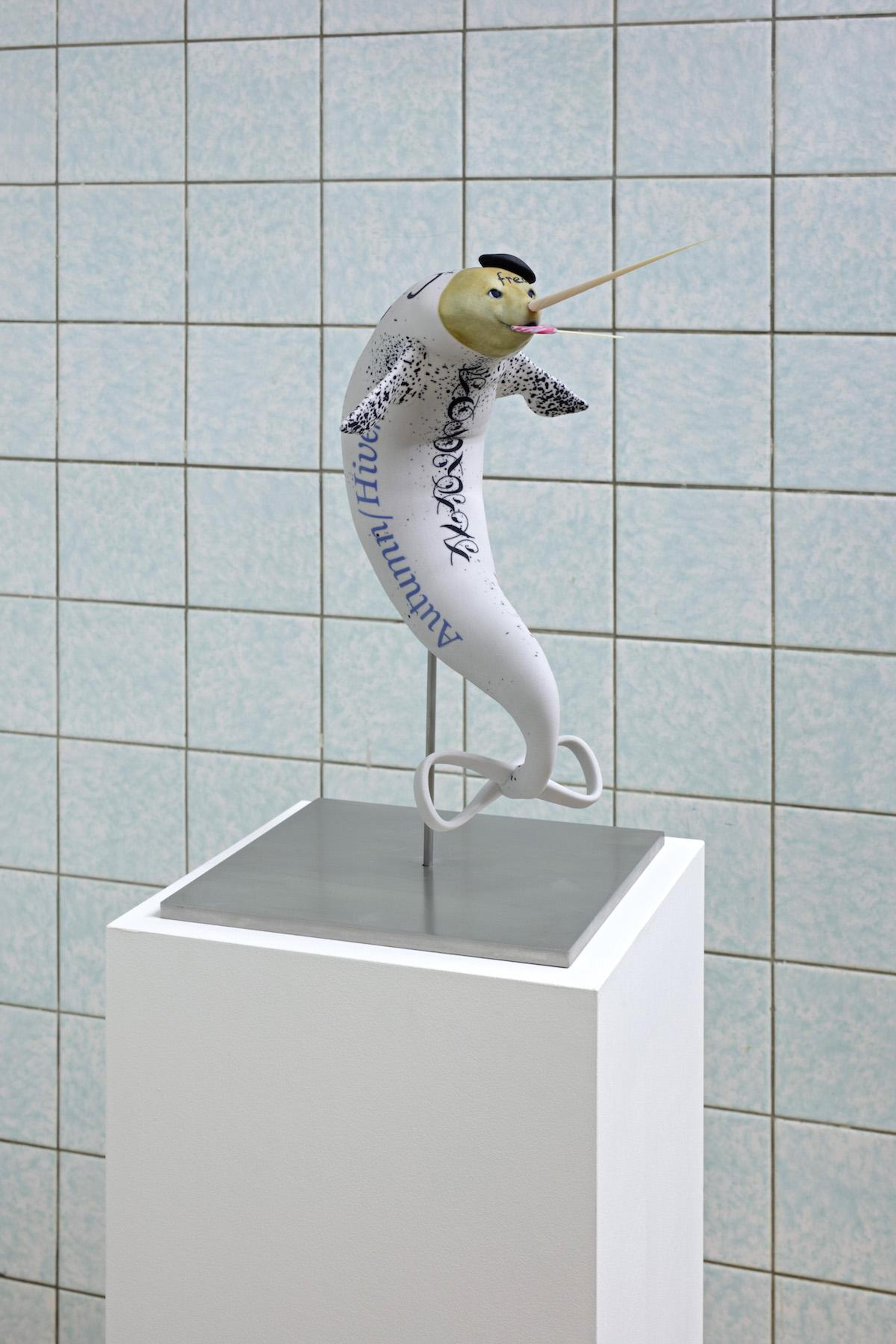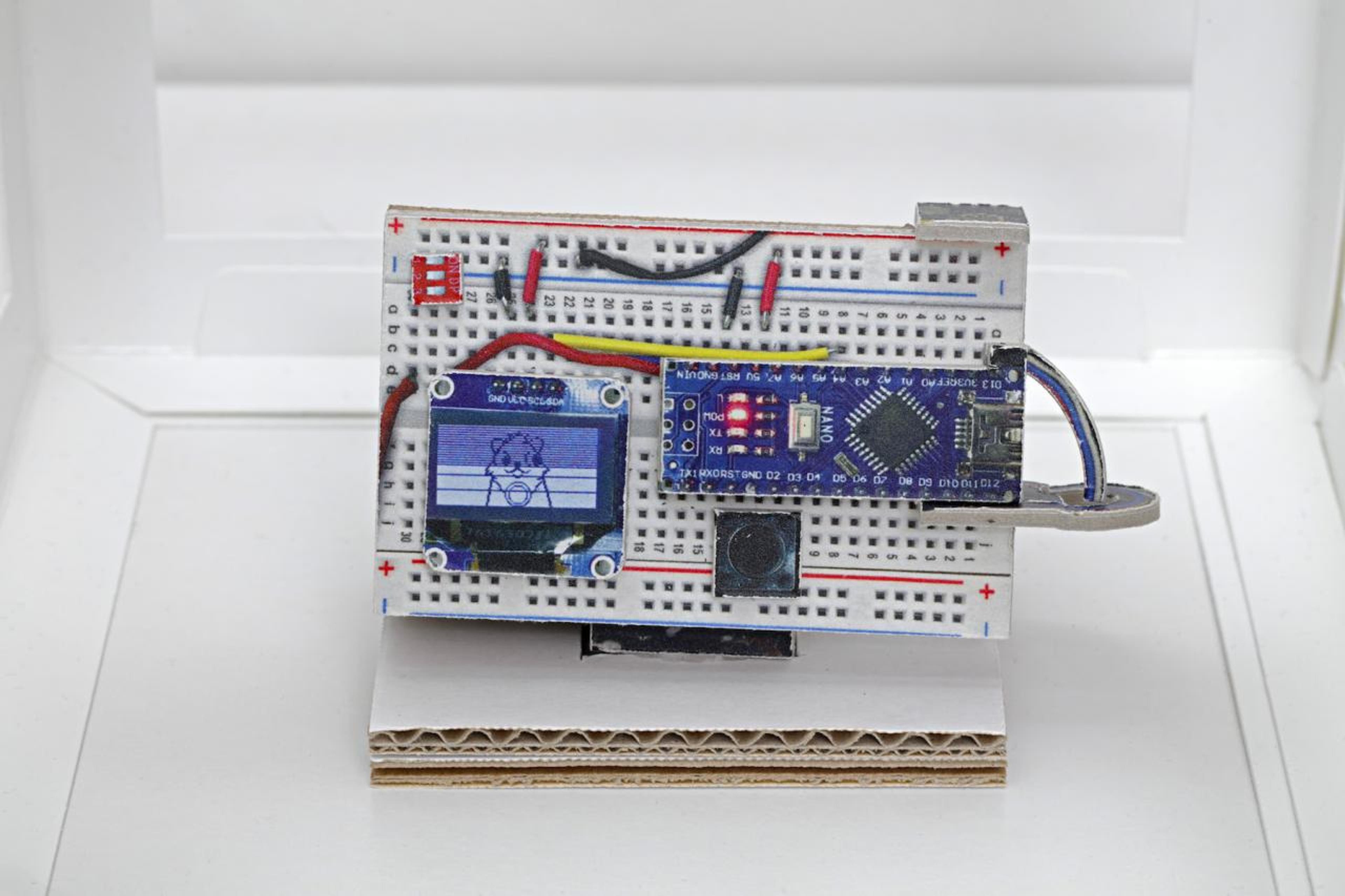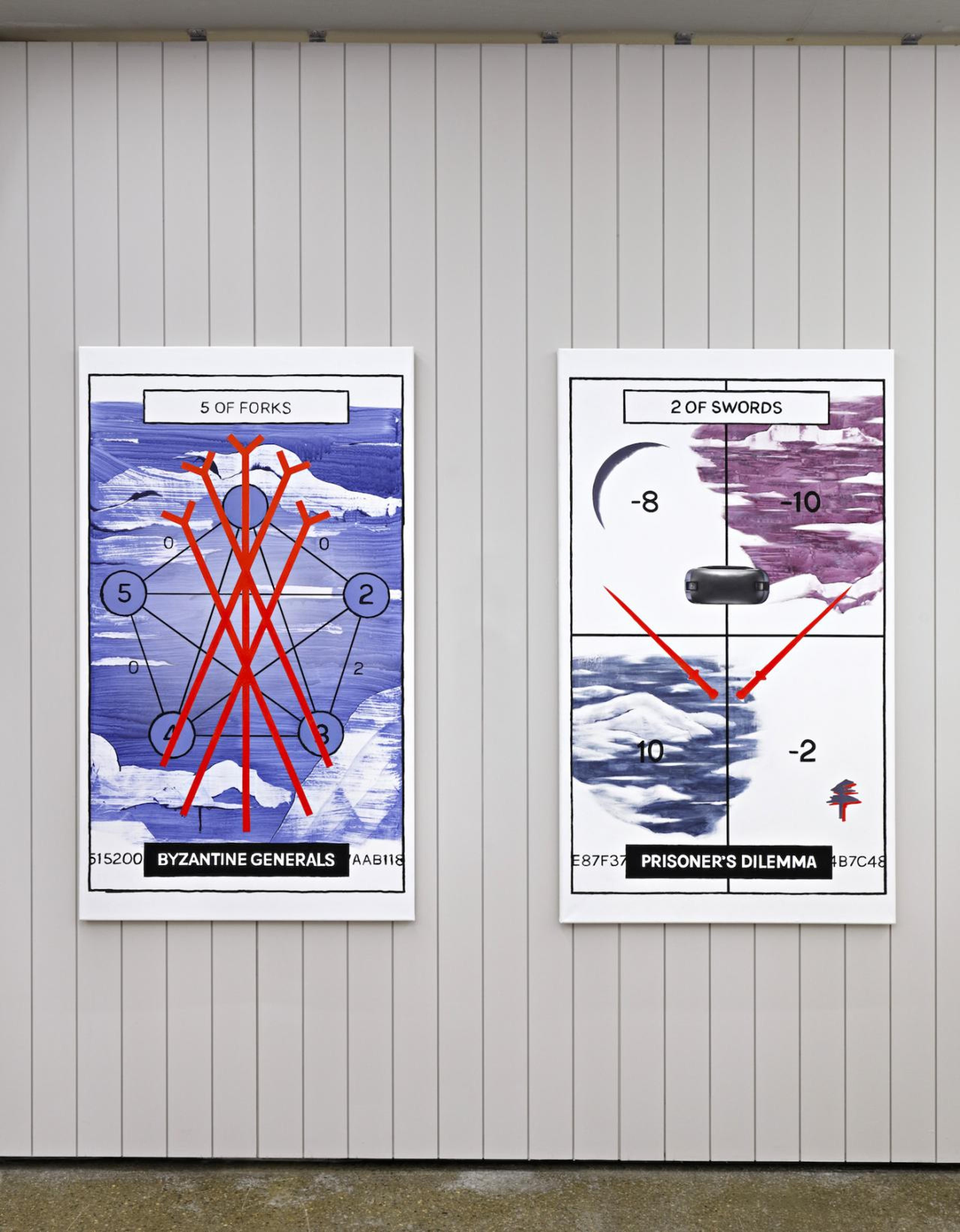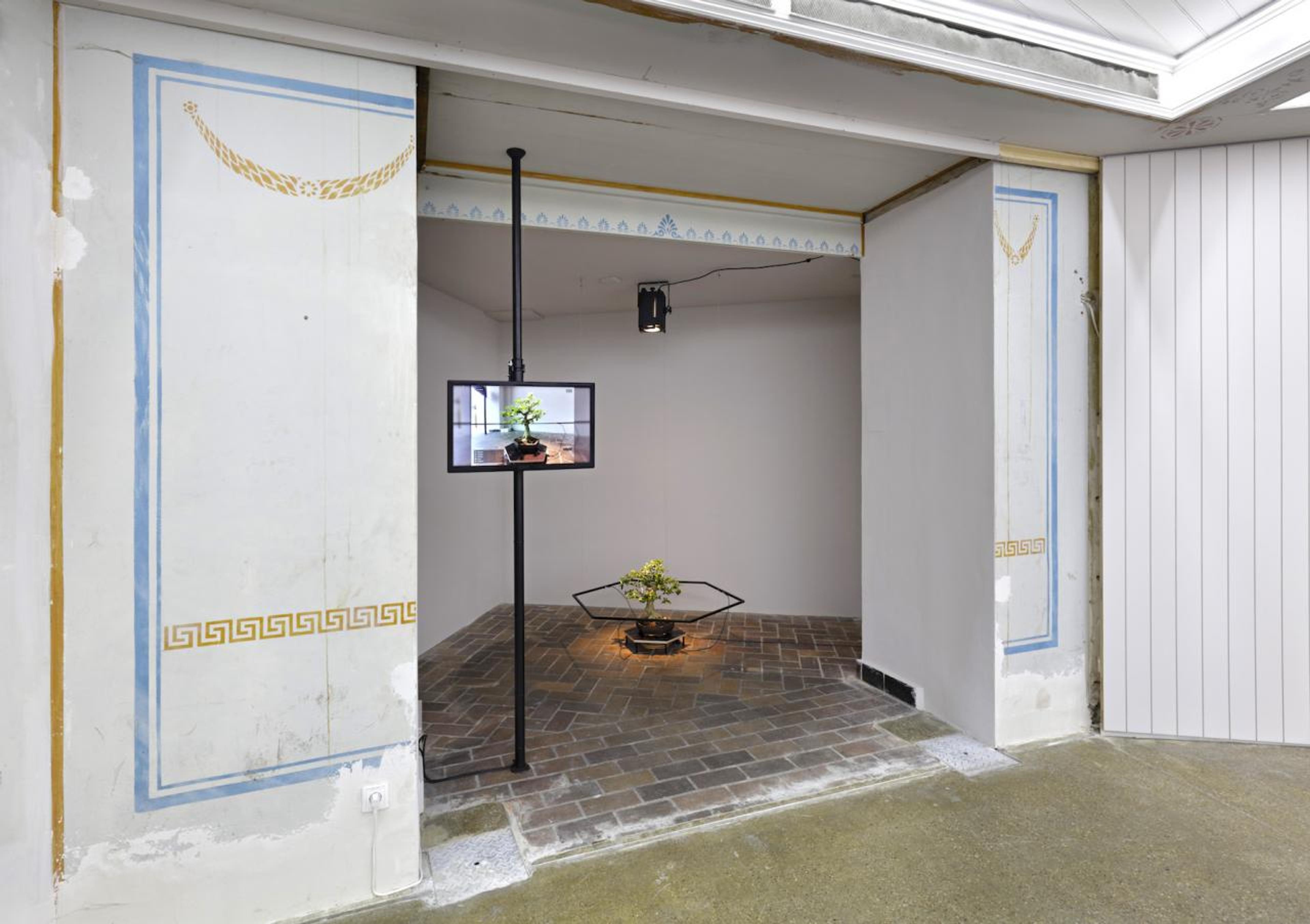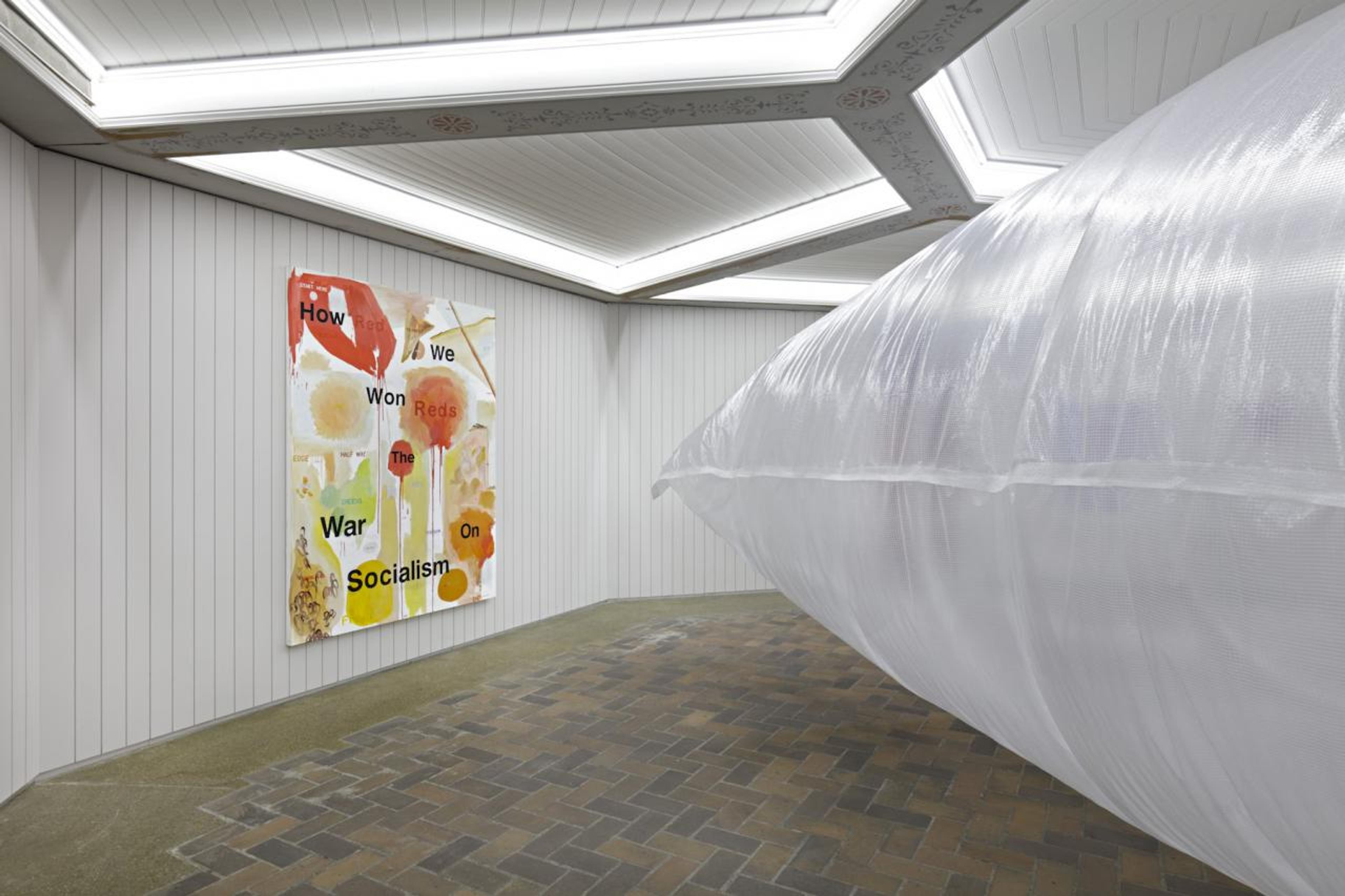Simon Denny is an artist who explores the cultural and ideological paraphenalia of tech – and one who has been paying attention to the blockchain, or cryptocurrency, community for a long time. It's a community that can take awhile to figure out ... it attracts utopians of all kinds, comes with a many-headed jargon hydra (from in-jokes to technical terms), and enough chaff (we call them shitcoins) that it's hard to tell sometimes if there's any wheat in there.
It can be difficult to separate the content of an artwork from its context, and in the case of blockchain art – from its financialization. “Proof of Work”, the Schinkel Pavillon exhibition curated by Denny, in collaboration with a number of other artists, doesn't try. It puts the elephant-sized kitty in the middle of the room. Its name is Celestial Cyber Dimension and it wants you to go to Burning Man. Turns out, the message Alice was sending to Bob was a little bottle, and around its neck was a paper label that said "BUY ME".
I had the good fortune of being in Berlin when the exhibition opened and when Spike approached me to interview Simon about the show I was eager to find out more. And hey – I've been here for a while too. Long enough to remember the wolves howling “Mooooooon” in trollbox. Long enough to know what that even means.
FOAM Tropical Mining Station (2017) Installation view, "Proof of Work", Schinkel Pavillon, 2018. Photo: Hans-Georg Gaul
“Proof of Work” is the exhibition title – we could say every artwork is its own “proof of work,” in a way. I’m curious to hear what it means for you in the context of this exhibition?
Since I heard the name of the Nakamoto proof system, it seemed like a suggestive poetic phrase. For me, the beauty of artists exploring the culture around crypto was to frame it as a “proof”, different than a mathematical proof, that shows your computer has been expending energy solving cryptographic problems. The artistic work of teasing out cultural meaning in relationship to emergent technologies has inspired me for a long time. Each of these artworks is a proof of that cultural work – evidence of the poetic unpacking of the unique bundle of technology, energy, cryptography, politics, attention, hijacking, promise, and disappointment that has gathered at the border of art and blockchain over the last few years.
The project is curated in dialogue with other artists, including an exhibition-within-an-exhibition by Sarah Hamerman and Sam Hart. Can you describe how you structured those relationships?
After my 2016 exhibition “ Blockchain Future States ” at Petzel in Chelsea I was invited to present my work at a prominent Ethereum-related conference in Brooklyn, run by Joseph Lubin’s development consortium Consensys, called “Ethereal” (some more poetic branding). There I met Sam Hart who was curating an exhibition on art and crypto inside a Tropical Mining Station – an inflatable experiment in decentralised architecture, where an Ethereum miner’s exhaust is pumped into a semi-transparent room-sized tent structure – by Katja Zavyalova and Ryan John King of FOAM .
The event left a big impression on me – the gathering of experimental artworks inside this literal crypto bubble, during one of the fastest growing moments of crypto's hype cycle, seemed to me a wonderful artistic collective collage as complex and dynamic as the crypto phenomenon itself. When the Schinkel Pavillon invited me to curate an exhibition I contacted Sam and through dialogue with him and Sarah Hamerman, whom he introduced me to, came to this idea of devising a simple “curatorial protocol” which would perform the idea of a transparent, distributed curating practice.
Left: FOAM Tropical Mining Station (2017) Right: 0xΩ Dogewhal (2018) Installation view, Proof of Work, Schinkel Pavillon, 2018 Photo: Hans-Georg Gaul
Why did you take this collaborative approach?
I wanted other artists/technologists/thinkers to make decisions about what would be in the exhibition, and I wanted the protocol to identify exactly the community these decisions were coming out of. I wanted the curating to be transparent and distributed, like blockchains are often described as being. So more than just Sam and Sarah, I also reached out to other curatorial “nodes” in an ideal network of people who could suggest and co-curate projects for the exhibition: Kei Kreutler, Aude Lunay, Harm van den Dorpel, and the collective Distributed Gallery . I worked on these dialogues closely with my then-assistant, Anna-Lisa Scherfose. The conversations were pretty casual, each node bringing their own take to the exhibition. Distributed Gallery suggested Cryptokitties , a group that were firmly from the crypto world, and Harm brought his crypto gallery project left gallery to the table. It was interesting representing a whole group of artists working to create digital artworks that are enabled with blockchain-based payments and infrastructure.
There was a loosely rule-based structure for each interaction, and then I produced a diagram making this network of decisions and people transparent
You said you wanted the curating to also be transparent, how was this accomplished?
Sam and Sarah were really into producing a thematic show within a show that looked at “secrets”. So there was a loosely rule-based structure for each interaction, and then I produced a diagram making this network of decisions and people transparent – trying to resonate with the ledger on a blockchain that shows all transactions and cannot be erased. This is reproduced in the little guidebook I wrote for the exhibition and is visualised on the wall as you enter the Schinkel Pavillon. A lot of the making of the work – be it commissioning Kei’s paintings, remaking custom versions of FOAM’s bubbles, or figuring out how to 3D print an edition of Avery Singer and Matt Liston’s crypto totem – was done by my studio and the Schinkel Pavillon. I was quite involved in the material realisation of the exhibition, a bit like a producer or maybe an exhibition “dev”.
Aria Dean BLACKBOX (2017) Installation view, Proof of Work, Schinkel Pavillon, 2018 Photo: Hans-Georg Gaul
What are some of the most interesting broader conversations about blockchain art you see from these pieces in dialogue? Can you talk a little bit about how the show was installed, in what seemed to be literal crypto bubbles?
Well the FOAM inflatables really do a lot for suggesting the promise of bitcoin and other blockchains to me. They are literally giant speculative bubbles inflated by the exhaust, or the heat, produced by crypto mining. I positioned artworks in and around these in two different clusters. Distributed Gallery’s money-burning, crypto-issuing jukebox, the Chaos Machine is in the bubble, hinting to a narrative of the threat of crypto’s atmosphere to the legitimacy of existing state-issued “fiat” money and a general mood of possible accelerationist nihilism.
Then beside the bubble sits the more optimistic terra0 self-sovereign tree with its possibility of non-human entities becoming legal agents in capital flows. This work to me suggests the kind of alternative systems, “access to tools” narratives that is also part of crypto culture – from the Earth to the Biosphere, or something like that, as a ghost resonating with previous waves of techno-idealism. Next to that, Wayne Lloyd’s painting How We Won the War on Socialism (2000) suggests both the format of a meme (the painting to me anticipates meme and image tagging formats with glib text over a kind of quoted and generic abex painting style) and the political narrative of promoting freedom in the context of expanding capitalism that came packaged both with the abstract expressionism of the 1950s and also with the seductive stories around the spread of bitcoin, suggested in David Golumbia’s book The Politics of Bitcoin: Software as Right Wing Extremism .
I think these community-governance-facilitated-by-blockchain ideas seem to be among the more exciting ideas proposed for art-blockchain infrastructure
How We Won the War on Socialism seems like a transition point – from the complex ideological intersections of the blockchain world to the next room …
Yes, the cluster of works surrounding the second FOAM bubble in the back room of the exhibition unpack the notion of cryptocurrencies as attention-hacks or memes, reminding again how the technology is also a story and one of the fundamental ways in which crypto works is by the promise of more granular monetisation of attention through a web where likes could carry monetary value with them. Matt Liston and Avery Singer’s crypto totem, part of their speculative crypto religious infrastructure project called 0xΩ, is a kind of meme-animal 3D print with a unicorn’s horn (as in the billion dollar company nickname), the face of the meme doge (famous for also being the face of the cryptocurrency Dogecoin), the body of a whale (a market moving major-player), and styled up in vapourware-like brand names and colours with an infinity tail. That artwork is outside the bubble and inside the bubble is a monument to the sale of the $140,000 Cryptokitty tamagotchi-like meme-resembling crypto-collectible at the Codex/Christie ’s auction, again in association with Consensys. We borrowed the original hardware wallet from its collector and displayed it inside a meticulous cardboard reconstruction of the sale display from Christie’s NYC offices.
Harm van den Dorpel Nested Exchange Series (2018) Installation view, Proof of Work, Schinkel Pavillon, 2018 Photo: Hans-Georg Gaul
Projects like Decentralized Autonomous Kunstverein and Decal suggest new possibilities for artists to self-organise with blockchains. What about these possibilities excites you, or inversely, concerns you?
I think these community-governance-facilitated-by-blockchain ideas seem to be among the more benign/exciting ideas proposed for art-blockchain infrastructure. I’m curious and optimistic about such experiments, which are not really about finance in their essence; they’re more about restructuring collective governance in a small-scale, local way. I just came back from Miami where there was a conference organised by art-adjacent billionaire Adam Lindemann and much of the conversation explored emergent fractal ownership models and blockchain-based ownership provenance infrastructure. The suggestion by Marc Glimcher, CEO of Pace Gallery, and others at the conference was fractal ownership for big ticket items. He said there are 800,000 people who follow Pace’s Instagram who are not and will never be clients of the gallery as buyers of artwork, but that he would like to find a way to financially include them in a relationship to the most premium art brands and artists, and that fractal ownership could incentivise communities to come together resembling social networks formed around owning a piece of a blue chip artwork. These seem to me like increasingly different conversations around what art and blockchain’s relationship could be – but perhaps they’re closer than I think.
This has been an interest of yours for some time, and I saw the Petzel show you mentioned, “Blockchain Future States”, which used large board games to represent different aspects of the blockchain world and also had a big statue of Ash Ketchum. What's the connection for you between blockchain and gaming?
People into blockchain seem like they are often into games and gaming – gaming hardware is repurposed for mining cryptocurrencies, game design and game theory are a part of the design skill set necessary for those who are blockchain developers and entrepreneurs. Game theory and networked systems designed through cybernetics has a long history too. Ruth Catlow, a prominent artist and thinker in this space, designs board games and just led a workshop at Kunst-Werke while refining and testing a TCR modeled board game she prototyped with Ben Vickers. The Pokémon naming story told by could-be-bitcoin-founder/Satoshi Nakamoto candidate Craig Wright, which inspired the Ash sculpture, goes like this (from Andrew O’ Hagan’s LRB article describing his interaction):
“I noticed a book on the worktop called Visions of Virtue in Tokugawa Japan. I’d done some mugging up by then and was keen to nail the name thing.
‘So that’s where you say you got the Nakamoto part?’ I asked. ‘From the 18th-century iconoclast who criticised all the beliefs of his time?’
‘Yes.’
‘What about Satoshi?’
‘It means “ash”,’ he said. ‘The philosophy of Nakamoto is the neutral central path in trade. Our current system needs to be burned down and remade. That is what cryptocurrency does – it is the phoenix …’
‘So satoshi is the ash from which the phoenix …’
‘Yes. And Ash is also the name of a silly Pokémon character. The guy with Pikachu.’ Wright smiled. ‘In Japan the name of Ash is Satoshi,’ he said.”
Distributed Gallery Chaos Machine (2018) Installation view, Detail, Proof of Work, Schinkel Pavillon, 2018 Photo: Hans-Georg Gaul
I'm interested in the ways the gotta-catch-em-all of Pokémon anticipates cryptokitties like Celestial Cyber Dimension?
Oh me too. The amount of times I went to a blockchain meet-up and heard the phrase “Pokémon Go for crypto” describing this or that project ...
Should we make NFTs (non-fungible tokens) for Pokémon?
There you go. Yes.
If you were a Pokémon, which one would you be?
Ho-oh, obviously. I made a sculpture with him in it – he is able to resurrect from the dead.
“Proof of Work”
Schinkel Pavillon
8 September – 23 December, 2018
SARAH FRIEND is an artist and a software engineer ( @isthisanart_ ).
Mark Lombardi Middle East Broadcasting Centre (London) (c. 2000) Photo: Hans-Georg Gaul
CryptoKitties / Guile Gaspar Celestial Cyber Dimension, (Kitty . 127.) (2018) displayed in: Simon Denny Cardboard CryptoKitty 127 Auction Display Replica (2018) Installation view, Proof of Work, Schinkel Pavillon, 2018 Photo: Hans-Georg Gaul
0xΩ Dogewhal (2018) Installation view, Proof of Work, Schinkel Pavillon, 2018. Photo: Hans-Georg Gaul
CryptoKitties / Guile Gaspar Celestial Cyber Dimension, (Kitty . 127.) (2018) displayed in: Simon Denny Cardboard CryptoKitty 127 Auction Display Replica (2018) Installation view, Proof of Work, Schinkel Pavillon, 2018 Photo: Hans-Georg Gaul
Kei Kreutler The Pareto Deck: 5 of Forks (2018) Photo: Hans-Georg Gaul
terra0 Premna Daemon (2018) Installation view, Proof of Work, Schinkel Pavillon, 2018 Photo: Hans-Georg Gaul
terra0 Premna Daemon (2018) Installation view, Proof of Work, Schinkel Pavillon, 2018 Photo: Hans-Georg Gaul
Wayne Lloyd How We Won the War on Socialism (2000) Installation view, Proof of Work, Schinkel Pavillon, 2018. Photo: Hans-Georg Gaul
Wayne Lloyd How We Won the War on Socialism (2000) Installation view, Proof of Work, Schinkel Pavillon, 2018. Photo: Hans-Georg Gaul
"Proof of Work", Installation view, Schinkel Pavillon, 2018 Photo: Hans-Georg Gaul


